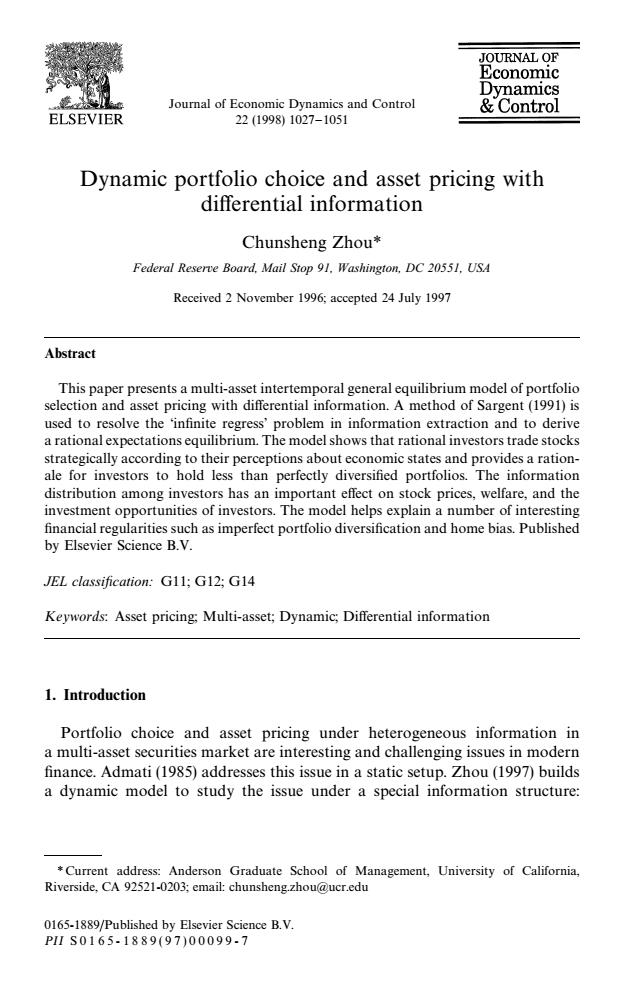正在加载图片...

JOURNAL OF Economic Dynamics Journal of Economic Dynamics and Control Control ELSEVIER 22(1998)1027-1051 Dynamic portfolio choice and asset pricing with differential information Chunsheng Zhou* Federal Reserve Board,Mail Stop 91.Washington,DC 20551.USA Received 2 November 1996;accepted 24 July 1997 Abstract This paper presents a multi-asset intertemporal general equilibrium model of portfolio selection and asset pricing with differential information.A method of Sargent(1991)is used to resolve the 'infinite regress'problem in information extraction and to derive a rational expectations equilibrium.The model shows that rational investors trade stocks strategically according to their perceptions about economic states and provides a ration- ale for investors to hold less than perfectly diversified portfolios.The information distribution among investors has an important effect on stock prices,welfare,and the investment opportunities of investors.The model helps explain a number of interesting financial regularities such as imperfect portfolio diversification and home bias.Published by Elsevier Science B.V. JEL classification:G11;G12;G14 Keywords:Asset pricing:Multi-asset;Dynamic;Differential information 1.Introduction Portfolio choice and asset pricing under heterogeneous information in a multi-asset securities market are interesting and challenging issues in modern finance.Admati(1985)addresses this issue in a static setup.Zhou(1997)builds a dynamic model to study the issue under a special information structure: *Current address:Anderson Graduate School of Management,University of California, Riverside,CA 92521-0203;email:chunsheng.zhou@ucr.edu 0165-1889/Published by Elsevier Science B.V. PI1S0165-1889(97)00099-7* Current address: Anderson Graduate School of Management, University of California, Riverside, CA 92521-0203; email: chunsheng.zhou@ucr.edu Journal of Economic Dynamics and Control 22 (1998) 1027—1051 Dynamic portfolio choice and asset pricing with differential information Chunsheng Zhou* Federal Reserve Board, Mail Stop 91, Washington, DC 20551, USA Received 2 November 1996; accepted 24 July 1997 Abstract This paper presents a multi-asset intertemporal general equilibrium model of portfolio selection and asset pricing with differential information. A method of Sargent (1991) is used to resolve the ‘infinite regress’ problem in information extraction and to derive a rational expectations equilibrium. The model shows that rational investors trade stocks strategically according to their perceptions about economic states and provides a rationale for investors to hold less than perfectly diversified portfolios. The information distribution among investors has an important effect on stock prices, welfare, and the investment opportunities of investors. The model helps explain a number of interesting financial regularities such as imperfect portfolio diversification and home bias. Published by Elsevier Science B.V. JEL classification: G11; G12; G14 Keywords: Asset pricing; Multi-asset; Dynamic; Differential information 1. Introduction Portfolio choice and asset pricing under heterogeneous information in a multi-asset securities market are interesting and challenging issues in modern finance. Admati (1985) addresses this issue in a static setup. Zhou (1997) builds a dynamic model to study the issue under a special information structure: 0165-1889/Published by Elsevier Science B.V. PII S0165-1889(97)00099-7